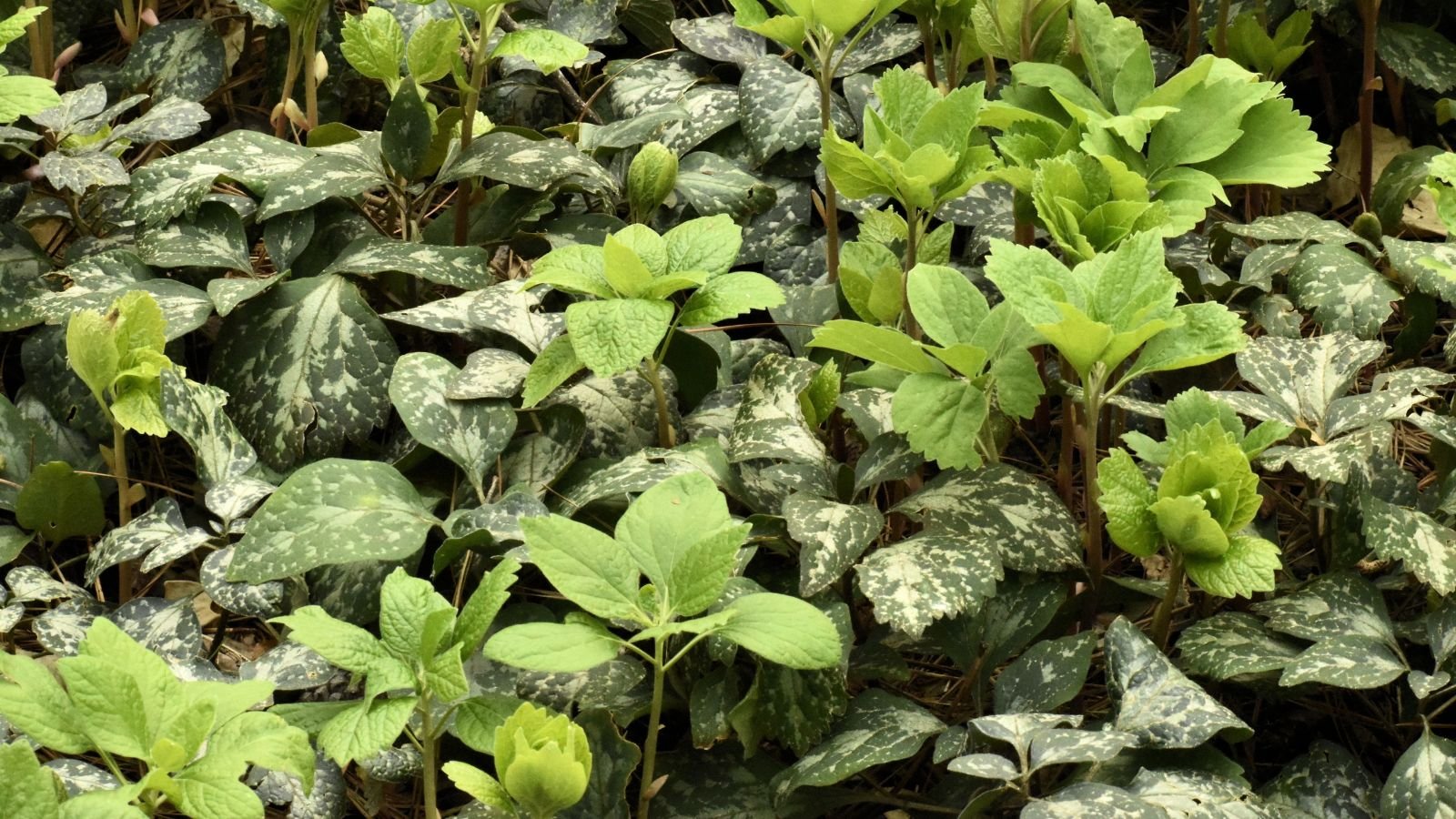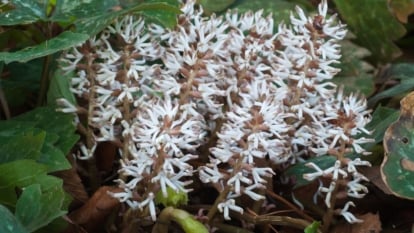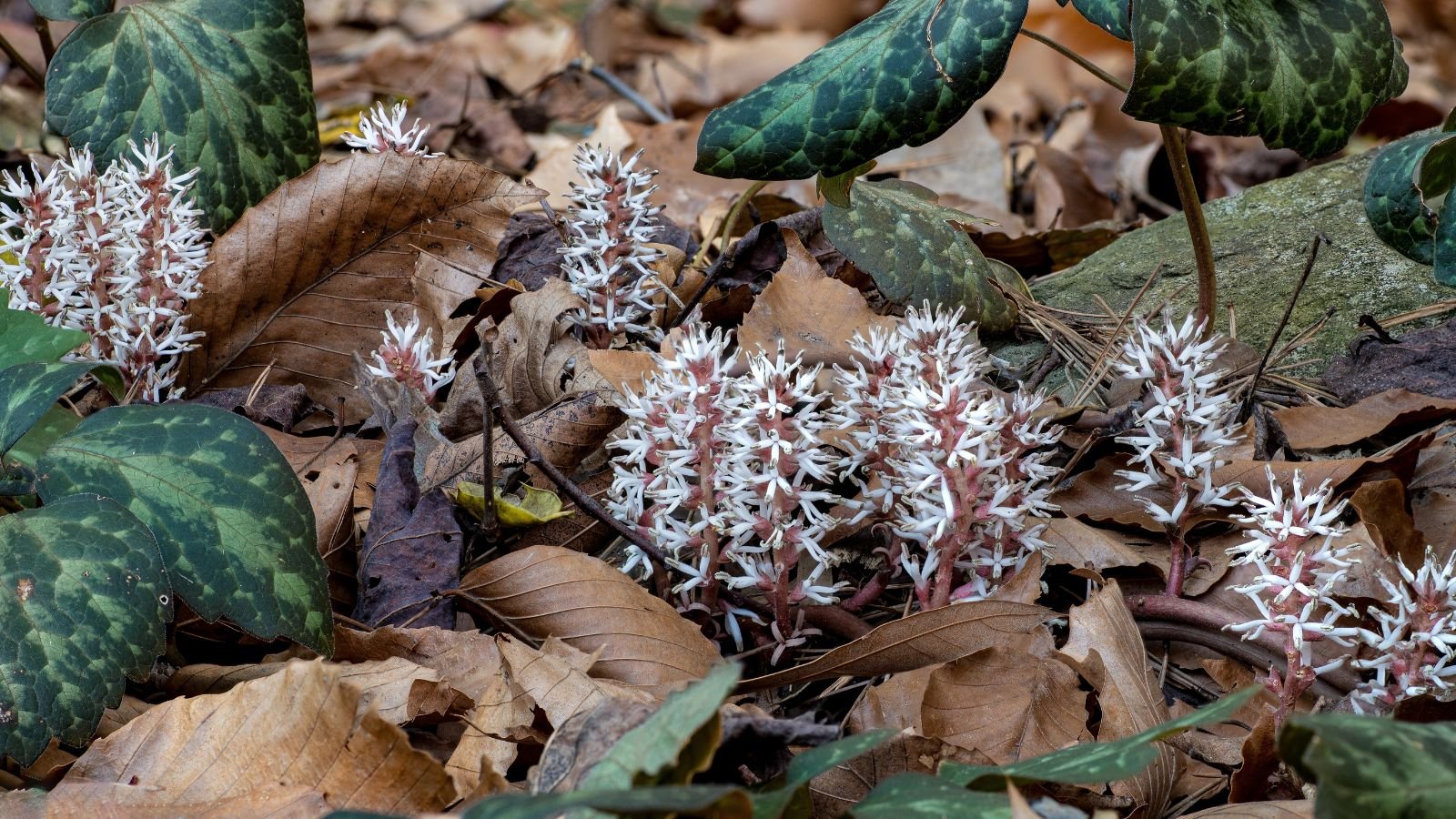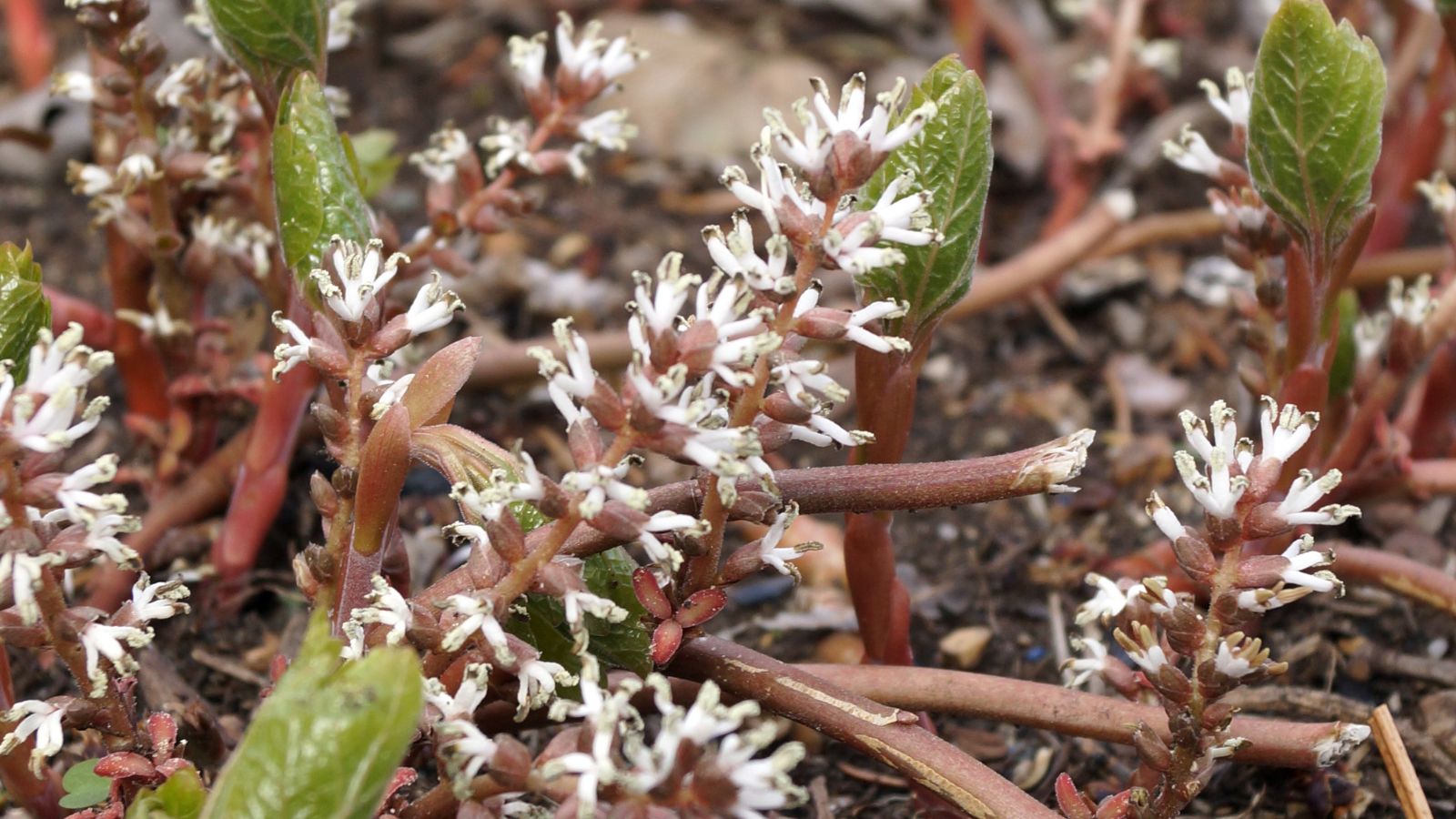How to Plant, Grow, and Care for Allegheny Spurge (Pachysandra Procumbens)
Pachysandra procumbens, also called Allegheny spurge, is a low, easy-growing ground cover. For both sun and shade, this native is a good spreading evergreen subshrub that is also non-invasive. Lorin Nielsen will help you get started in this comprehensive growing guide.

Contents
Allegheny spurge, scientifically known as Pachysandra procumbens, is an easy-growing woodland plant. Crisp green foliage provides a beautiful shrubby ground cover for all terrains. A bit slow to get started, it becomes a vibrant carpet over time and spreads slowly to fill available space.
This shade-loving semi-evergreen is one of many native plants of the United States. Its origins are in the southeast part of the country, and it’s found in abundance there. But the popularity of this spurge has spread to other regions.
So let’s see what the Allegheny spurge has to offer for our southern friends!
Plant Overview

|
Plant Type
Evergreen subshrub ground cover
Family
Buxaceae
Genus
Pachysandra
Species
Pachysandra procumbens
|
Native Area
South Eastern USA
Exposure
Full sun to partial shade
Height
8-12”
Watering Requirements
Moderate
|
Pests & Diseases
Aphids, slugs, scale, spider mites, blight, rot
Maintenance
Low
Soil Type
Well-draining, rich loam
Hardiness Zone
5-9
|
What is Allegheny Spurge
As an excellent ground cover or border plant, the Alleghany spurge is perfect. Growing not much taller than about six inches in height, it creeps outward via underground rhizomes.
Native Area
It’s one of the US native plants, spreading as a woodland plant with a rhizomatous ground cover habit through the forest floors of West Virginia, Kentucky, Florida, and Louisiana. While Pachysandra procumbens can grow easily in zones 5-9, cooler climates have a different effect on this plant. It is deciduous in zones 5-6 but evergreen in zones 7-9. This is, in part, why it’s so popular in the woodland gardens of the Southeast.
Characteristics

Allegheny spurge has matte blue-green leaves rather than shiny ones. It may be dappled with hints of purple or white. The leaves have toothed edges at their tips, but they smooth out towards the leaf base. They may reach up to three inches in length.
The spreading erect stems tend to be four to six inches long, sometimes slightly longer. They are surprisingly easy to root as cuttings but do not develop roots on their own.
Unlike other species of pachysandra, it is non-invasive. It’s often stated that procumbens is among plants that form a dense carpet ground cover, too!
Pachysandra procumbens does flower, but they are not particularly showy when the white flowers bloom. They develop in two to four-inch fragrant white flower spikes, which are sometimes greenish or pinkish. This bloom happens in early spring before new leaf growth appears.
Planting

To improve fertility and drainage, prepare the area by loosening the soil and mixing in compost or leaf mold. Space the plants about 12-18 inches apart to allow room for spreading. Dig holes deep enough to cover the roots without burying the crown, and gently firm the soil around the plants.
Water thoroughly after planting, and add a layer of mulch to retain moisture and suppress weeds. Keep the soil consistently moist until the plants are established, after which they require minimal care. They are ideal for erosion control and shaded areas, Pachysandra procumbens slowly spreads to form a dense, attractive mat.
How to Grow
Let’s talk about everything you need to get your Pachysandra procumbens to form a dense carpet of matte blue green leaves. It’s actually fairly easy to care for, but providing the right environment starts it off right.
Light

As the foliage of your Allegheny spurge can easily sun-bleach, it’s best if grown in dappled or full shade. This plant thrives in the shade of large trees, where sunlight filters through the canopy. While it can handle brief exposure to direct sunlight, too much intense sun, especially in hot climates, may scorch the leaves and cause stress.
Water

Consistent medium moisture is good for Allegheny spurge It doesn’t require heavy watering, but it likes the soil to be moist at all times. An inch a week is likely all you’ll need to keep it happy.
If your Pachysandra procumbens are less than two years old, provide slightly more frequent watering in those initial years. This ensures they have the medium moisture they need to develop good foliage and form a dense carpet of matte blue-green leaves.
Avoid overhead watering. It is susceptible to leaf blight, and this can make problems worse. When possible, use a soaker hose at the base of the plant for slow, gradual watering.
Tolerant of southeastern US humidity, your Pachysandra procumbens can hold on in both dry and wet air conditions. It will accept dryer air, of course, but seems to thrive at about 50% humidity.
Soil

Your Allegheny spurge likes mildly acidic soil. Aim for a range that is 5.5-6.5 pH. If you’re not sure about your soil’s pH level, do a pH test before you plant. This gives you the ability to amend the soil before planting.
Organically rich, well-draining soil is necessary for Pachysandra procumbens to thrive and form a dense carpet. It should remain consistently moist for best development. Adding peat moss to your soil can help with moisture retention. Leaf mold is another great option, as is forest humus. Ensure excess water drains away easily.
Temperature

Temperature-wise, your Pachysandra procumbens prefers moderate climates. It grows well outdoors in zones 5 to 9. Even in moderate climates, it can begin to look a bit ragged in winter, but it recovers once warm weather returns.
Fertilizer

Fertilizing in the early spring is best for your Pachysandra procumbens. Most spurge species prefer a balanced fertilizer. Slow-release granular options are easiest to apply around your shrubby ground cover plants. Follow the manufacturer’s instructions for application.
Apply your fertilizer just as new growth begins to form. If necessary, you can apply a second dose in early summer. Usually it isn’t necessary to apply more fertilizer, as the plant is not a heavy feeder and its white flowers bloom either way. It will form a dense carpet through its rhizomatous ground cover habit regardless.
Maintenance

Pachysandra procumbens tends to stay around six inches, so you may not need to prune for height. If you’re using it as a dense carpet ground cover, this requires medium maintenance. You can set your lawnmower at four inches and trim it down to a consistent size if you wish.
Slow-growing, this spurge doesn’t tend to be invasive like its relative Pachysandra terminalis. That one, the Japanese spurge, will rapidly invade other spaces. With your Alleghany spurge, you should find that light edge trimming keeps it in check.
Propagation

Propagation from softwood cuttings is the most common method for spurges. They will readily form roots and create new plants via their rhizomatous ground cover habit.
Taking softwood cuttings from your Pachysandra procumbens is best in the early spring or late fall. Select newer growth before white flowers bloom, and cut off a piece that is at least four inches long. Dip the end into rooting hormone and place into moistened potting soil. Keep the soil moist while roots form.
You can also divide the rhizome of your Pachysandra procumbens. Select a larger plant and cleanly cut through the center to divide it in half. A sterile, sharpened shovel blade works well for this purpose. You can then transplant one half while the other remains in place.
Common Problems
Little troubles this spurge species that thrives in woodland gardens. Let’s go over what few problems may arise while you’re growing your Pachysandra procumbens!
Growing Problems
Yellowing leaves can be a symptom of one of two major problems. Soil which is too alkaline can cause this issue. Pachysandra procumbens prefer a slightly-acidic soil, and if the pH is too high, they won’t thrive. They can develop pale green or yellowish-looking leaves or be stunted in growth. Raising the acidity of the soil can help with this.
The other problem comes from too much sunlight. Full sun conditions can cause the leaves of your plant to bleach. Yellow-green leaves are common in this situation. They may appear burned or become brittle. Ensure your plants are in partial to full shade.
Multicolor leaves are not uncommon on a dense carpet of Allegheny spurge. As seasons change, you may notice your pachysandra developing silvery or whitish leaf patterns. This is not harmful to your plant and, in fact, is sometimes referred to as the plant “opening its windows to let in the light”. It’s particularly common in autumn when the days are growing shorter.
Pests

Most pests tend to ignore this ground cover. Those that do are opportunistic and are usually found on multiple plants simultaneously. Aphids are among these opportunistic pests. Treatment of these can be as simple as using a hard spray of water to rinse them off. Applying neem oil can keep these at bay.
Slugs are also quite common, as the spurge provides both shelter from the sun and food. Using an organic snail and slug bait provides the best protection for your plants.
Other less common pests include spider mites and scale. Both are fairly rare on your spurge. Neem oil is a common preventative for these as well.
Diseases

Volutella stem and leaf blight strikes multiple types of pachysandra. While Pachysandra procumbens is more tolerant of it than other forms, it can still strike. This fungal blight causes cankers on erect stems. It also creates tan to brown spots on leaves, which gradually increase in size. Over time, the leaf blight can completely cover the leaf surface.
Promoting good air circulation around your spurge plants helps reduce volutella blight. It is more common in damp or rainy conditions, so avoid overhead watering. As the weather warms up, it’s less prone to develop.
A variety of root or stem rots can also form in overly moist conditions. These mainly develop in poorly drained soil. Fungal causes include pythium, fusarium, or alternaria among others. For these, prevention is better than trying to cure. Ensure you have well-drained soils and that roots won’t be in standing water.
Frequently Asked Questions
Can I grow Pachysandra procumbens as a lawn replacement?
You can if you’ve got a partially to fully shaded lawn area. While short periods of full sun may not do severe damage, longer periods will. This plant is excellent as a ground cover under the shade of trees or in shaded areas alongside buildings.
Is fertilizing absolutely necessary for Allegheny spurge?
Is it required? No. Does it help the plant to develop and spread in well-drained soils? Yes. If you’re trying to avoid commercial fertilizers, you can apply about an inch of compost in the spring around your plant. That should give it the nutrition required for growth. Regular fertilizers are just easier to apply.
Is Pachysandra procumbens invasive?
The short answer is not really. While other forms of pachysandra are, particularly Pachysandra terminalis, procumbens is a member of groups of slow-growing native plants. It can and does spread over time, but it’s easy to manage and not considered invasive.
What is the best time of year to plant Pachysandra?
Plant it in temperate fall or spring, and do so when the plant has enough time to establish itself before the cold of winter or heat of early summer sets in.
What happens to Pachysandra in the winter?
Unless you live in an area with arctic winters, it should remain green. You may see some die back in cooler zones, but overall the plant will survive.
Will Pachysandra take over grass?
Yes. It is known to take over nearby vegetation and garden beds.









